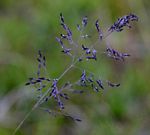Eragrostis inamoena
Selected images: Click on each image to see a larger version and details of the record View all images (1)
Detailed records: Display species records QDS maps by: Google Maps Point records by Google Maps
Species details: Click on each item to see an explanation of that item (Note: opens a new window)
| Synonyms: |
Eragrostis atrovirens sensu Sturgeon, sensu Chippindall, non (Desf.) Steud. Eragrostis friesii sensu B.K. Simon, non Pilg. Eragrostis galpinii Stent Eragrostis gangetica sensu Stent & J.M. Rattray, non (Roxb.) Steud. Eragrostis sp. (Simon & Williamson 2035) of Simon |
| Common names: | Tite grass (English) |
| Frequency: | Common |
| Status: | Native |
| Description: |
Caespitose perennial with short oblique rhizome; culms slender, up to 100 cm tall, erect, unbranched, glabrous at the nodes, eglandular; basal leaf sheaths glabrous, chartaceous, usually compressed, eglandular, persistent; ligule a line of hairs; leaf laminas 4–25 cm × 2–4 mm, linear, usually involute, glabrous, eglandular.Panicle 7–25 cm long, broadly ovate, loose to moderately dense, the spikelets evenly distributed on pedicels 2–4 mm long, the primary branches not in whorls, terminating in a fertile spikelet, glabrous in the axils, eglandular.Spikelets 5–20 × 2–3(3.5) mm, narrowly oblong, laterally compressed, 9–40-flowered, the florets disarticulating from below upwards, the rhachilla persistent; glumes subequal, 1.2–2 mm long, reaching to between 2/3 and 3/4 the way along the adjacent lemmas, keeled, lanceolate in profile, glabrous, acute at the apex; lemmas 1.7–2.5 mm long, keeled, ovate in profile, membranous with distinct lateral nerves, diverging from the rhachilla at c. 45°, those in opposite rows not imbricate, the rhachilla visible between them, greyish-green to dark green, minutely asperulous, acute or subacute at the apex; palea deciduous with or soon after the lemma, glabrous on the flanks, the keels slender, wingless, scaberulous; anthers 3, 0.7–1 mm long.Caryopsis 0.7–1 mm long, narrowly elliptic. |
| Type location: |
|
| Notes: | Perennial tufted grass, growing from rhizomes. The inflorescence is typically an open panicle of purple spikelets (green when young) with sharply pointed tips. The spikelets are often curved. |
| Derivation of specific name: | |
| Habitat: | In wet places, such as vlei margins and road side seepage areas. |
| Altitude range: (metres) | Up to 1570 m |
| Flowering time: | Nov - May |
| Worldwide distribution: | Tropical Africa southwards to South Africa |
| FZ divisions: | N,W,C,E,S |
| Growth form(s): | |
| Endemic status: | |
| Red data list status: | |
| Insects associated with this species: | |
| Spot characters: | Display spot characters for this species |
| Literature: |
Chapano, C. & Mamuto, M. (2003). Plants of the Chimanimani District National Herbarium and Botanic Garden, Zimbabwe Page 24. Chapano, C. & Mugarisanwa, N.H. (2003). Plants of the Matobo District National Herbarium and Botanic Garden, Zimbabwe Page 15. Cope, T.A. (1999). Poaceae Flora Zambesiaca 10(2) Page 113. Heath, A. & Heath, R. (2009). Field Guide to the Plants of Northern Botswana including the Okavango Delta Kew Publishing Page 494. (Includes a picture). Mapaura, A. & Timberlake, J. (eds) (2004). A checklist of Zimbabwean vascular plants Southern African Botanical Diversity Network Report No. 33 Sabonet, Pretoria and Harare Page 104. Ntore, S. & al. (2024). Checklist of the vascular plants of Burundi Page 196. Poilecot, P. (2007). Eragrostis species of Zimbabwe Éditions Quae,Versailles, France Pages 138 - 139. (Includes a picture). Roodt, V. (2015). Grasses & Grazers of Botswana and the surrounding savanna Struik Nature, South Africa Pages 114 - 115. (Includes a picture). Setshogo, M.P. (2005). Preliminary checklist of the plants of Botswana. Sabonet Report no. 37. Sabonet, Pretoria and Gaborone Page 137. Timberlake, J.R. & Childes, S.L. (2004). Biodiversity of the Four Corners Area: Technical Reviews Volume Two (Chapter 5-15) Appendix 5-1: Plant Checklist Occasional Publications in Biodiversity 15 Page 189. |
Other sources of information about Eragrostis inamoena:
Our websites:
Flora of Botswana: Eragrostis inamoenaFlora of Burundi: Eragrostis inamoena
Flora of Caprivi: Eragrostis inamoena
Flora of Malawi: Eragrostis inamoena
Flora of Mozambique: Eragrostis inamoena
Flora of Zambia: Eragrostis inamoena
External websites:
African Plants: A Photo Guide (Senckenberg): Eragrostis inamoenaAfrican Plant Database: Eragrostis inamoena
BHL (Biodiversity Heritage Library): Eragrostis inamoena
EOL (Encyclopedia of Life): Eragrostis inamoena
GBIF (Global Biodiversity Information Facility): Eragrostis inamoena
Google: Web - Images - Scholar
iNaturalist: Eragrostis inamoena
IPNI (International Plant Names Index): Eragrostis inamoena
JSTOR Plant Science: Eragrostis inamoena
Mansfeld World Database of Agricultural and Horticultural Crops: Eragrostis inamoena
Plants of the World Online: Eragrostis inamoena
Tropicos: Eragrostis inamoena
Wikipedia: Eragrostis inamoena
